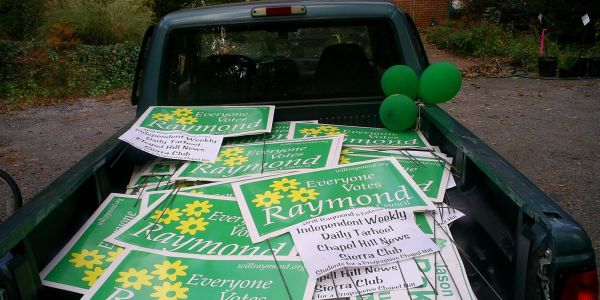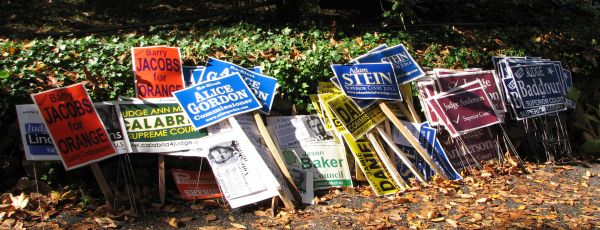I do know that the Sierra Club, in 2005, thought I was a candidate well-suited for addressing our Town’s environmental issues.
Will Raymond has been one of the most outspoken and effective citizen activists in Chapel Hill in recent years. We look forward to him using his talents to advocate for the environment as a member of Town Council. In particular we are excited about his initiatives to promote energy efficiency in town buildings. He will also work to protect lesser known creeks in the Chapel Hill area and to minimize the number of single occupancy vehicles causing air pollution and traffic congestion at Carolina North.
We strongly encourage Sierra Club members and any residents of Chapel Hill who care about the environment to support these four candidates in the November 8th election. They are the best hope for a Town Council that will always make reducing environmental impact a top priority as Chapel Hill grows bigger.
With two years of additional activism – on Carolina North, energy efficiency, open space and environmental protections, Roger Road, environmental standards – by the very measure the Club used in 2005, one might expect a 2007 endorsement.
Over the last two years, I knew I had built a solid reputation for putting our environment front and center. I brought to the table a number of established innovative solutions for reducing environmental impacts, promoting sustainable alternatives and reusing/recycling wasted resources.
Above all, I kept it simple: “Walk the talk.”
As recently as this Spring, when our Council wavered on eco-friendly standards for their Downtown development, I was there making the case for measurable goals. Three of the incumbents, Hill, Strom and Greene, voted for their public-private project even though the developer refused to be held to a goal of %20 energy reduction as measured by acceptable standards.
On the same project, I was there first on the hazardous waste remediation – sizing our obligation, funding the effort accordingly. The same three incumbents downplayed the costs to our Town’s open-ended obligation to clean up that environmental mess.
I’ve supported mandating ASHRAE and AIA 2030 environmental standards for energy efficient buildings, well beyond what some of the incumbents have called for.Beyond that, over the last two years I’ve lobbied (and successfully got) the Town to purchase bio-fuels for its fleet, though I’ve yet to get the majority to agree to targeted reductions in fuel use.
I’ve called for a stronger emphasis on reducing noise and light pollution, including adopting the precepts of the Dark Skies Initiative
As part of the Horace-William’s Citizens Committee (HWCC), I brought metrics to the environmental assay process – setting goals, discussing methodologies for measuring achievement of those goals.
Unfortunately, that necessary additional work was canceled when the Mayor pulled the plug on the HWCC. Fortunately, UNC’s Leadership Advisory Committee on Carolina North did listen and made a serious environmental assay of the Horace-William’s property a key requirement for moving forward.
On other issues, preserving open space, using the wasted landfill gas (LFG) for Town operations, teaming with the County on bio-fuels production, I have been at the forefront – calling for specific measures that would not only improve our local ecology but recycle/reuse wasted resources (two bangs for the same buck).
Whether it was right-sizing our Town’s vehicle fleet (still not done after a commitment to do so over 4 years ago), calling for the Town to get Duke Energy to use much more efficient light fixtures in our street lights (6 years now without action by Council), using technology to reduce car trips to the new Town Operations Center (ignored, and no longer championed by the dissolved Technology Board) – my efforts have been backed by solid, detailed, research and marked by a pragmatic, practical approach to solving problems.
Throughout, I’ve called on our Town to “walk the talk.”
Where was the concern for tree protection, for instance, when Southern Park was clear cut? Where was the commitment to carbon reduction (CRED) by reducing our Town’s fuel use or replanting appropriately at the new Town Operations center?
Lots of talk, but very poor follow through. Deeds, in the case of our incumbents, don’t always follow the words.
But it hasn’t just been about the environment. What about social justice?
Strangely ignored by our local Sierra Club, the environmental consequences of siting the landfill, and, now, the trash transfer station in the Rogers Road community have been well known for years. I remember two of the neighborhoods representatives, Fred Battle and Rev. Campbell, asking for relief at a Council meeting nearly eight years ago (and many times since).
They were asking Chapel Hill to make good on promises made a decade prior – to show some basic, decent, human concern.
The burden has only increased over the years but our elected folks have just not responded adequately to our neighbors just concerns. Many of their concerns – slowing down traffic, picking up spilled litter, improving the safety along Rogers Road – could be addressed by low cost means. Our Town, which has dumped trash in their backyards, could certainly allocate some funds to deal with the sewer and water problems.
Yet, two of our incumbents, Jim Ward and Bill Strom, over eight years, have moved slowly, if at all, to address this case of obvious environmental injustice. In spite of escalating requests, over the last four years, Cam Hill and Sally Greene joined Bill and Jim in mostly ignoring the pleas of our neighbors.
Yes, there was murmured concern but when it came to making measurable progress – the results were anemic – and quite unsatisfying to the Rogers Road community.
Not only have I spoken out on behalf of our neighbors, I’ve documented their case and have made specific proposals for addressing some of their concerns.
Why the Sierra Club refuses to address this environmental injustice in their own backyard I don’t know.
I do know that when I asked their political committee why I wasn’t asked about this glaring issue during my interview, two of the members told me that they thought it wasn’t part of the Club’s or Chapel Hill’s docket. I pointed out that the next Council will definitely be ruling on the County’s solid-waste plans and Rogers Road – even if we dispense with common neighborly courtesy – is squarely our Town’s concern.
In the recent League forum you can compare my response to those of the incumbents (40 minutes in).
Once you review the footage, I’d ask, “Who would you want standing in your corner?”
In 2005, the Sierra Club said I was a candidate well-suited for addressing our Town’s environmental issues:
Will Raymond has been one of the most outspoken and effective citizen activists in Chapel Hill in recent years. We look forward to him using his talents to advocate for the environment as a member of Town Council. In particular we are excited about his initiatives to promote energy efficiency in town buildings. He will also work to protect lesser known creeks in the Chapel Hill area and to minimize the number of single occupancy vehicles causing air pollution and traffic congestion at Carolina North.
Yes, these last two years, I built upon that activism – on Carolina North, energy efficiency, open space and environmental protection – the Sierra Club endorsed.
But I knew this year, because of Sierra Club politics at the State level, and because of my repeated calls to the Sierra Club’s leadership to take a principled stand on a number of environmental issues, I had very little chance to secure an endorsement. I had some small hope that the Club would surmount the politics and select the candidates that have shown the courage to “do” over those that have had the opportunity to “do more” and haven’t.
So, a small hope but little expectation. Given the Club’s assurance that they would carefully review my record, I did expect they would get my name right:
Dear Ray,
One great thing about Chapel Hill is that fact we have so many candidates with positive ideas about the environment and who have contributed to the community. Based upon the interviews, forum, voting records and other information we made our recomendation to the state Sierra Club. I’m glad to hear about your concerns about carrying capicity for Chapel Hill and hope you will continute to pursue them, however we decided to endorse other
candidates who had more experience. Thank you for spending time with us to share your ideas and thoughts and of
course, please keep on talking them up.
I was unable to post the forum. I am having copies made. If you contact me after Tuesday I can lend you a copy of the DVD.
Sincerely,
Loren Hintz
Voting records? I’ll have to wait for that opportunity. On every other 2005 Club expectation, I delivered.
As far as sharing my ideas and “talking them up” to promote a sustainable community that lives within the limits of its “carrying capacity” Loren, you can count on that.
Sincerely.





